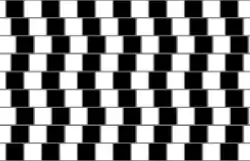

The café wall illusion, also known as the Münsterberg illusion,[1] is a geometrical-optical illusion in which the parallel straight dividing lines between staggered rows with alternating dark and light "bricks" appear to be sloped, not parallel as they really are.
A version of the illusion was first described by Hugo Münsterberg in 1894.[2][3][4] It has been rediscovered several times, including under the name kindergarten illusion in 1898 by A. H. Pierce,[5] and under its current name in 1973 by Richard Gregory.[6] According to Gregory, this effect was observed by a member of his laboratory, Steve Simpson, in the tiles of the wall of a café at the bottom of St Michael's Hill, Bristol.
In the construction of the illusion often each "brick" is surrounded by a layer of "mortar" intermediate between the dark and light colours of the "bricks".[7]
In attempts at its deconstruction, the illusion was ascribed largely to the irradiation illusion (apparent greater size of a white area than of a black one),[4][8] and the image disappears when black and white are replaced by different colours of the same brightness.[9] But a component of the illusion remains even when all optical and retinal components are factored out. Contrast polarities seem to be the determining factor in the tilt's direction.[10]


See also
References
- ↑ "Münsterberg illusion". Oxford Reference. Oxford University Press. Retrieved 15 May 2023.
- ↑ Day, Ross Henry (1978). "A note on the Münsterberg or café wall illusion". Perception. 7 (1): 123–124. doi:10.1068/p070123. Retrieved 15 May 2023.
- ↑ Münsterberg, Hugo (1894). Pseudoptics. New York: Milton Bradley.
- 1 2 Münsterberg, H. (1897). "Die verschobene Schachbrettfigur". Zeitschrift für Psychologie. 15: 184–88.
- ↑ Pierce, A. H. (1898). "The illusions of the kindergarten patterns" (PDF). Psychological Review. 5 (3): 233–53. doi:10.1037/h0070595.
- ↑ Gregory, R. L.; Heard, P. (1979). "Border locking and the Café Wall illusion" (PDF). Perception. 8 (4): 365–80. doi:10.1068/p080365. PMID 503767.
- ↑ Morgan, M. J.; Moulden, B. (1986). "The Münsterberg figure and twisted cords". Vision Research. 26 (11): 1793–1800. doi:10.1016/0042-6989(86)90130-6.
- ↑ Pierce, A. H. (1901). Studies in Auditory and Visual Space Perception. London: Longmans Green.
- ↑ Westheimer, G. (2007). "Irradiation, border location and the shifted-chessboard pattern". Perception. 36 (4): 483–94. doi:10.1068/p5646.
- ↑ Kitaoka, A; Pinna, B.; Brelstaff, G. (2004). "Contrast polarities determine the direction of Cafe Wall tilts" (PDF). Perception. 33 (1): 11–20. doi:10.1068/p3346. PMID 15035325.
External links
- An interactive web app for demonstrating the Café wall illusion
- An interactive version of the Café wall illusion that allows for adjusting the offset and turning the black boxes into white boxes
- An animated proof that the horizontal lines are parallel and straight
- The original café in Bristol on Google Maps Street View